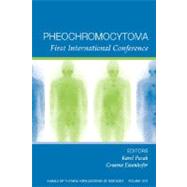
Note: Supplemental materials are not guaranteed with Rental or Used book purchases.
Purchase Benefits
What is included with this book?
Karel Pacak is a professor who established the Pheochromocytoma Research Program at the NIH, one of the most prestigious and largest programs worldwide, and has published over 80 articles/book chapters on this topic. He has Introduced new biochemical and imaging approaches to this tumor, especially the use of 18F-fluorodopamine in localization of pheochromocytoma. He also developed new biochemical and imaging algorithms for pheochromocytoma for practicing physicians. Moreover, developed new animal model of metastatic pheochromocytoma. Currently working as the Chief of Section on Medical Neuroendocrinology, NICHD. He is also Professor of Medicine at Georgetown University, Washington DC and Charles University, Prague, Czech Republic.
Graham Eisenhofer is a clinical biochemist with broad experience in basic and patient-oriented research on neuroedocrine and autonomic nervous system function in health and disease. Relevant achievements include codevelopment with Dr. Jacques Lenders of the first HPLC method for measurements of plasma free metanephrines, a test now used for improved biochemical diagnosis of pheochromocytoma. Dr. Eisenhofer was also responsible for initial development of 18F-fluorodopamine as a positron emission tomographic imaging agent for visualizing sympathetic nerves and neuroendocrine tumors. Dr. Eisenhofer co-chairs the Pheochromocytoma RESearch Support ORganization.
| Preface. | |||||
|
xv | ||||
| Part I. Presentation and Differential Diagnosis | |||||
|
|||||
|
1 | (20) | |||
|
|||||
|
21 | (9) | |||
|
|||||
|
30 | (8) | |||
|
|||||
|
38 | (9) | |||
|
|||||
|
47 | (5) | |||
|
|||||
|
52 | (7) | |||
|
|||||
|
59 | (20) | |||
|
|||||
|
79 | (7) | |||
|
|||||
|
86 | (8) | |||
| Part II. Genetics: Increasing Importance for Clinical Decision Making | |||||
|
|||||
|
94 | (10) | |||
|
|||||
|
104 | (8) | |||
|
|||||
|
112 | (10) | |||
|
|||||
|
122 | (16) | |||
|
|||||
|
138 | (11) | |||
|
|||||
|
149 | (7) | |||
|
|||||
|
156 | (10) | |||
|
|||||
|
166 | (11) | |||
|
|||||
|
177 | (6) | |||
|
|||||
|
183 | (7) | |||
|
|||||
|
190 | (8) | |||
|
|||||
|
198 | (5) | |||
|
|||||
|
203 | (5) | |||
| Part III. Tumor Biology, Molecular Pathways, and Genotype Phenotype Relationships | |||||
|
|||||
|
208 | (13) | |||
|
|||||
|
221 | (13) | |||
|
234 | (7) | |||
|
234 | (7) | |||
|
|||||
|
241 | (12) | |||
|
|||||
|
253 | (10) | |||
|
|||||
|
263 | (7) | |||
|
|||||
|
270 | (7) | |||
|
|||||
|
277 | (7) | |||
|
|||||
|
284 | (6) | |||
|
|||||
|
290 | (10) | |||
|
|||||
|
300 | (6) | |||
|
|||||
|
306 | (6) | |||
|
|||||
|
312 | (5) | |||
|
|||||
|
317 | (15) | |||
| Part IV. Biochemical Diagnosis and Tumor Localization | |||||
|
|||||
|
332 | (16) | |||
|
|||||
|
348 | (10) | |||
|
|||||
|
358 | (16) | |||
|
|||||
|
374 | (9) | |||
|
|||||
|
383 | (9) | |||
|
|||||
|
392 | (13) | |||
| Part V. Management | |||||
|
|||||
|
405 | (12) | |||
|
|||||
|
417 | (12) | |||
|
|||||
|
429 | (7) | |||
|
|||||
|
436 | (8) | |||
|
|||||
|
444 | (5) | |||
| Part VI. Malignant Pheochromocytoma | |||||
|
|||||
|
449 | (16) | |||
|
|||||
|
465 | (26) | |||
|
|||||
|
491 | (7) | |||
|
|||||
|
498 | (7) | |||
|
|||||
|
505 | (7) | |||
|
|||||
|
512 | (5) | |||
|
|||||
|
517 | (10) | |||
|
|||||
|
527 | (6) | |||
|
|||||
|
533 | (8) | |||
|
|||||
|
541 | (16) | |||
| Part VII. Pathology | |||||
|
|||||
|
557 | (14) | |||
|
|||||
|
571 | (7) | |||
|
|||||
|
578 | (7) | |||
| Index of Contributors | 585 |
The New copy of this book will include any supplemental materials advertised. Please check the title of the book to determine if it should include any access cards, study guides, lab manuals, CDs, etc.
The Used, Rental and eBook copies of this book are not guaranteed to include any supplemental materials. Typically, only the book itself is included. This is true even if the title states it includes any access cards, study guides, lab manuals, CDs, etc.